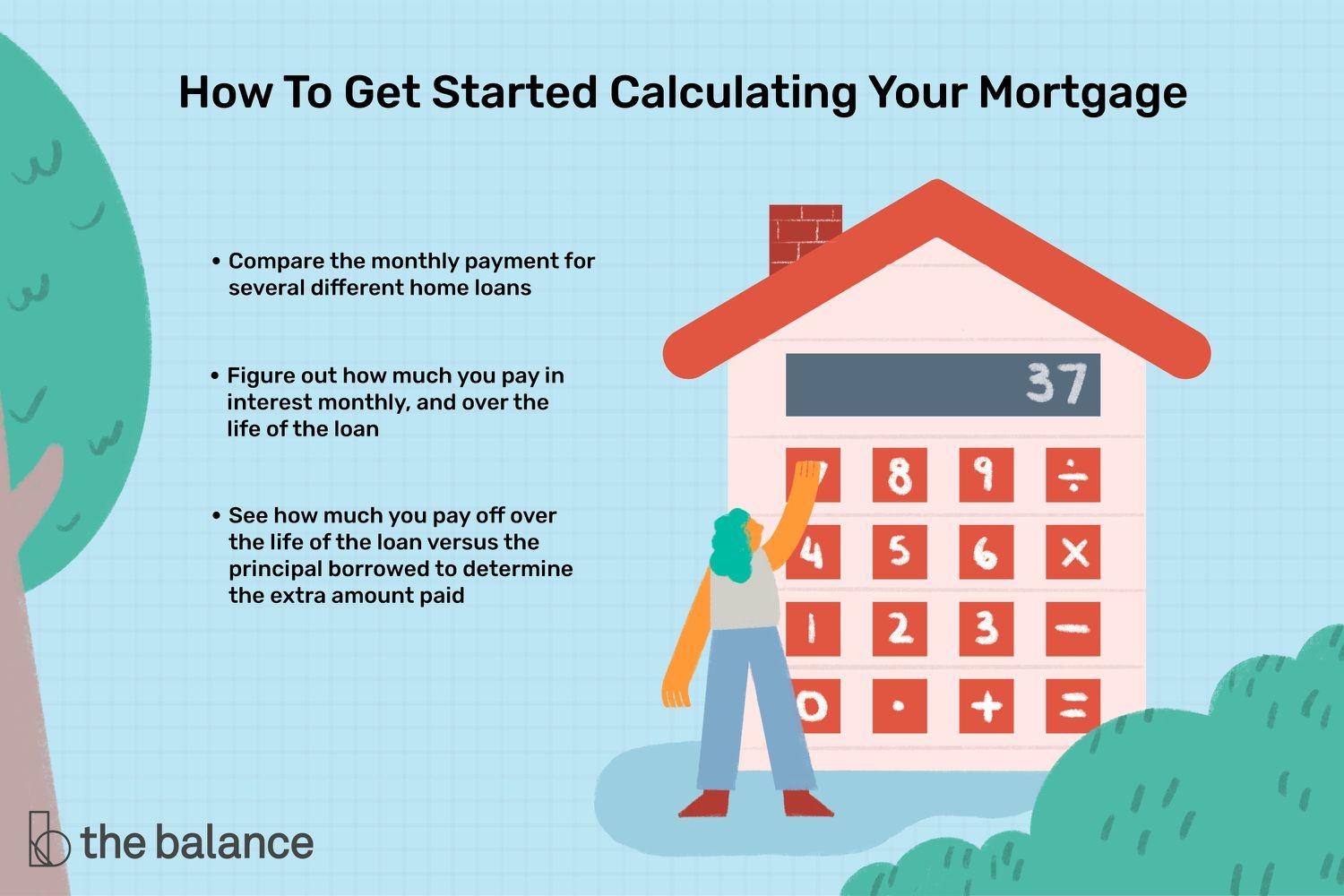Understanding your mortgage helps you make better financial decisions. Instead of just accepting offers blindly, it’s wise to look at the numbers behind any loan—especially a significant loan such as a home loan.
Key Takeaways
- You can calculate your monthly mortgage payment by using a mortgage calculator or doing it by hand.
- You'll need to gather information about the mortgage's principal and interest rate, the length of the loan, and more.
- Before you apply for loans, review your income and determine how much you’re comfortable spending on a mortgage payment.
Getting Started With Calculating Your Mortgage
People tend to focus on the monthly payment, but there are other important features you can use to analyze your mortgage, such as:
- Comparing the monthly payment for several different home loans
- Figuring how much you pay in interest monthly and over the life of the loan
- Tallying how much you actually pay off over the life of the loan versus the principal borrowed, to see how much you actually paid extra
Use the mortgage calculator below to get a sense of what your monthly mortgage payment could end up being,
Your monthly mortgage payment will depend on your home price, down payment, loan term, property taxes, homeowners insurance, and interest rate on the loan (which is highly dependent on your credit score). Use the inputs below to get a sense of what your monthly mortgage payment could end up being.
The Inputs
Start by gathering the information needed to calculate your payments and understand other aspects of the loan. You need the details below. The letter in parentheses tells you where we’ll use these items in calculations (if you choose to calculate this yourself, but you can also use online calculators):
- The loan amount (P) or principal, which is the home-purchase price plus any other charges, minus the down payment
- The annual interest rate (r) on the loan, but beware that this is not necessarily the APR, because the mortgage is paid monthly, not annually, and that creates a slight difference between the APR and the interest rate
- The number of years (t) you have to repay, also known as the "term"
- The number of payments per year (n), which would be 12 for monthly payments
- The type of loan; for example, fixed-rate, interest-only, adjustable
- The market value of the home
- Your monthly income
Calculations for Different Loans
The calculation you use depends on the type of loan you have. Most home loans are standard fixed-rate loans.1 For example, standard 30-year or 15-year mortgages keep the same interest rate and monthly payment for their duration.
For these fixed loans, use the formula below to calculate the payment.2 Note that the carat (^) indicates that you’re raising a number to the power indicated after the carat.
Payment = P x (r / n) x (1 + r / n)^n(t)] / (1 + r / n)^n(t) - 1
Example of Payment Calculation
Suppose you borrow $100,000 at 6% for 30 years, to be repaid monthly. What is the monthly payment? The monthly payment is $599.55.
Plug those numbers into the payment formula:
- {100,000 x (.06 / 12) x [1 + (.06 / 12)^12(30)]} / {[1 + (.06 / 12)^12(30)] - 1}
- (100,000 x .005 x 6.022575) / 5.022575
- 3011.288 / 5.022575 = 599.55
You can check your math with the Loan Amortization Calculator spreadsheet.
How Much Interest Do You Pay?
Your mortgage payment is important, but you also need to know how much of it gets applied to interest each month. A portion of each monthly payment goes toward your interest cost, and the remainder pays down your loan balance. Note that you might also have taxes and insurance included in your monthly payment, but those are separate from your loan calculations.3
An amortization table can show you—month-by-month—exactly what happens with each payment. You can create amortization tables by hand, or use a free online calculator and spreadsheet to do the job for you. Take a look at how much total interest you pay over the life of your loan. With that information, you can decide whether you want to save money by:
- Borrowing less (by choosing a less-expensive home or making a larger down payment)
- Paying extra each month
- Finding a lower interest rate
- Choosing a shorter-term loan (15 years instead of 30 years, for example) to speed up your debt repayment
Note
Shorter-term loans such as 15-year mortgages often have lower rates than 30-year loans. Although you would have a bigger monthly payment with a 15-year mortgage, you would spend less on interest.4
Interest-Only Loan Payment Calculation Formula
Interest-only loans are much easier to calculate. Unfortunately, you don’t pay down the loan with each required payment, but you can typically pay extra each month if you want to reduce your debt.5
Suppose you borrow $100,000 at 6% using an interest-only loan with monthly payments. What is the payment? The payment is $500.
Loan Payment = Amount x (Interest Rate / 12)
Loan payment = $100,000 x (.06 / 12) = $500
Check your math with the interest-only calculator on Google Sheets.
In the example above, the interest-only payment is $500, and it will remain the same until:
- You make additional payments beyond the required minimum payment. Doing so will reduce your loan balance, but your required payment might not change right away.
- After a certain number of years, you’re required to start making amortizing payments to pay down the debt.
- Your loan may require a balloon payment to pay off the loan entirely.
Adjustable-Rate Mortgage Payment Calculation
Adjustable-rate mortgages (ARMs) feature interest rates that can change, resulting in a new monthly payment. To calculate that payment:
- Determine how many months or payments are left.
- Create a new amortization schedule for the length of time remaining.
- Use the outstanding loan balance as the new loan amount.
- Enter the new (or future) interest rate.
Say you have a hybrid-ARM loan balance of $100,000, and there are 10 years left on the loan. Your interest rate is about to adjust to 5%. What will the monthly payment be? The payment will be $1,060.66.
Know How Much You Own (Equity)
It’s crucial to understand how much of your home you actually own. Of course, you own the home—but until it’s paid off, your lender has a lien on the property, so it’s not yours free-and-clear. The value that you own, known as your "home equity," is the home’s market value minus any outstanding loan balance.
You might want to calculate your equity for several reasons.
- Your loan-to-value (LTV) ratio is critical, because lenders look for a minimum ratio before approving loans. If you want to refinance or figure out how much your down payment needs to be on your next home, you need to know the LTV ratio.
- Your net worth is based on how much of your home you actually own. Having a million-dollar home doesn’t do you much good if you owe $999,000 on the property.
- You can borrow against your home using second mortgages and home equity lines of credit (HELOCs). Lenders often prefer an LTV below 80% to approve a loan, but some lenders go higher.6
Can You Afford the Loan?
Lenders tend to offer you the largest loan that they’ll approve you for by using their standards for an acceptable debt-to-income ratio. However, you don’t need to take the full amount—and it’s often a good idea to borrow less than the maximum available.
Before you apply for loans or visit houses, review your income and your typical monthly expenses to determine how much you’re comfortable spending on a mortgage payment. Once you know that number, you can start talking to lenders and looking at debt-to-income ratios. If you do it the other way around (ignoring your expenses and basing your housing payment solely on your income), you might start shopping for more expensive homes than you can afford, which affects your lifestyle and leaves you vulnerable to surprises.
Note
It’s safest to buy less and enjoy some wiggle room each month. Struggling to keep up with payments is stressful and risky, and it prevents you from saving for other goals.
Frequently Asked Questions (FAQs)
What is a fixed-rate mortgage?
A fixed-rate mortgage is a home loan that has the same interest rate for the life of the loan. This means your monthly principal and interest payment will stay the same. The proportion of how much of your payment goes toward interest and principal will change each month due to amortization. Each month, a little more of your payment goes toward principal and a little less goes toward interest.
What is an interest-only mortgage?
An interest-only mortgage is a home loan that allows you to only pay the interest for the first several years you have the mortgage. After that period, you'll need to pay principal and interest, which means your payments will be significantly higher. You can make principal payments during the interest-only period, but you're not required to.





